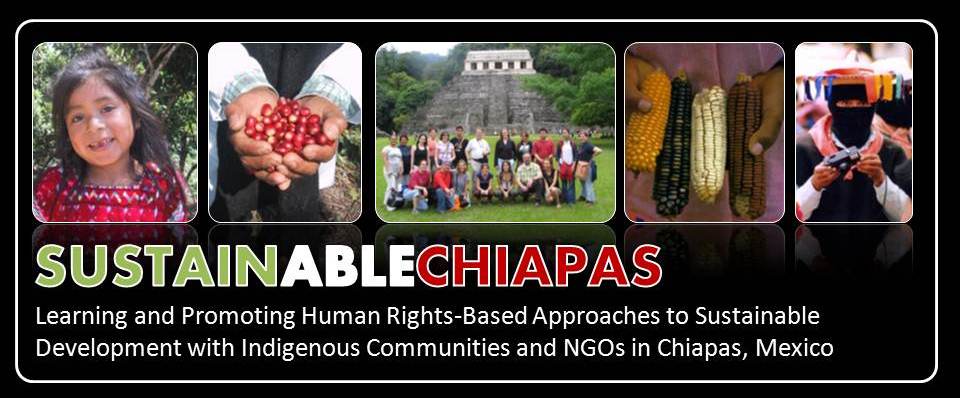 A familiar slogan used by the Zapatisa communites and their supporters is “Un mundo en que quepan muchos mundos” (A world in which many worlds fit). The slogan adorns the top of a brightly colored poster with images of people hand in hand, accepting and celebrating their diversity. Aside from the call for universal peace and harmony, I believe this slogan also serves as the foundation for a Zapatista (and overall indigenous) critique of the western development perspective and where it’s leading us. As Gustavo Castro Soto, the representative from a Mexican civil society organization called Otros Mundos Chiapas, told us “if every country on earth reached the lifestyle and consumption level of the US it would take 6 planets worth of resources to meet the need.” In other words, the development of the west (US, western Europe, Japan etc.) has created a world in which not even one earth can fit! This is the antithesis of sustainable. If the world continues to hold the paradigm of development as aspiring to be at the level of the west where will this lead us.
A familiar slogan used by the Zapatisa communites and their supporters is “Un mundo en que quepan muchos mundos” (A world in which many worlds fit). The slogan adorns the top of a brightly colored poster with images of people hand in hand, accepting and celebrating their diversity. Aside from the call for universal peace and harmony, I believe this slogan also serves as the foundation for a Zapatista (and overall indigenous) critique of the western development perspective and where it’s leading us. As Gustavo Castro Soto, the representative from a Mexican civil society organization called Otros Mundos Chiapas, told us “if every country on earth reached the lifestyle and consumption level of the US it would take 6 planets worth of resources to meet the need.” In other words, the development of the west (US, western Europe, Japan etc.) has created a world in which not even one earth can fit! This is the antithesis of sustainable. If the world continues to hold the paradigm of development as aspiring to be at the level of the west where will this lead us.As pointed out in John Bamba’s article Indigenous Peoples: Development with Culture and Identity, true sustainable development embraces the indigenous perspective of a relationship with the earth over the western perspective. The manipulation and domination of nature present in the western monoculture production, commercialization and privatization practices run counter to traditional indigenous views, which see the earth as an extension of humanity. While in Chiapas we learned that the Mayan cross was originally the symbol for a sacred tree, rooted in the ground of “Mother Earth,” representing humanity’s familial relationship with her. From this perspective, land, air and sea are not “assets” to be exploited, but family to be cared for and deeply respected.
One of the many lessons I learned through the Chiapas experience is the importance of understanding the differences of development perspectives and how to communicate them to others. If we in the west wish to show solidarity with the oppressed of the world, such as the indigenous peoples of Chiapas, we must start to integrate new ideas in our economic theories and shift our policies of domination towards cooperation. Sustainability has become a big buzzword for international developers, but how do we implement these practices? Not by idealizing indigenous cultures, there are oppressive systems at work there too (just ask members of Ki’nal Ansetik), but taking the spiritual/emotional wisdom of how to relate to the earth as an extension of humanity should help inform sustainable development efforts.
A reoccurring theme from discussion sessions in Chiapas is framing sustainable development as a human rights issue. No environmental, economic or political situation is sustainable if human beings’ basic rights to exist and subsist off of their own land are violated. Organized resistance to unjust economic systems can slowly help restore the integrity of the land and dignity of the people in some areas, but our job, as beneficiaries of economic dominance, is to help change the system from within. A human rights approach may prove useful for starting a dialogue on how sustainability is interwoven with systemic change.
1 I purchased a few copies of this poster along with many other Zapatista items at their community store in Oventik. Yes, even in the Zapatista communities my capitalist consumer habits were taken advantage of, but this time is was to support the struggle against injustice, so it’s ok right?
2 Ki’nal Ansetik is one of the most impressive organizations we visited in Chiapas. Most of their work revolves around empowering indigenous women. One of their main strategies is allowing young women to live in community at their center while they finish their high school or college educations with the goal of going back to their communities.
3 For example the neo-liberal policies of NAFTA which benefit the already dominant economic powers at the expense of the “underdeveloped.”
By Dan Pasquini
